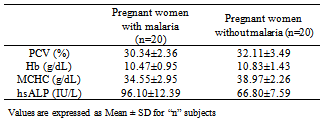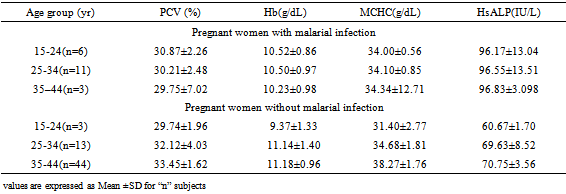-
Paper Information
- Next Paper
- Previous Paper
- Paper Submission
-
Journal Information
- About This Journal
- Editorial Board
- Current Issue
- Archive
- Author Guidelines
- Contact Us
Frontiers in Science
p-ISSN: 2166-6083 e-ISSN: 2166-6113
2012; 2(6): 200-202
doi: 10.5923/j.fs.20120206.11
Placental Alkaline Phosphatase Activity in Serum of Some Nigerian Pregnant Women Infected with Malaria
Onyesom I.1, Osioma E.2, Aguele M. O.1
1Department of Medical Biochemistry, Delta State University, Abraka , Nigeria
2Department of Biochemistry, Faculty of Science, University of Ilorin, Nigeria
Correspondence to: Osioma E., Department of Biochemistry, Faculty of Science, University of Ilorin, Nigeria.
| Email: |  |
Copyright © 2012 Scientific & Academic Publishing. All Rights Reserved.
Placental alkaline phosphatase, the heat-stable (hsALP) isoform is produced by the placenta and its activity has been associated with cord blood nutrients and proper foetal growth. Transplacental transmission of P.falciparum malaria has been reported and this has been observed to cause congenital malaria, anaemia and reduced neonatal birth weight, an evidence of poor growth. Changes in mean corpuscular haemoglobin concentration (MCHC), an index of anaemia and hsALP activity in serum of P.falciparum malarial infected pregnant women were therefore investigated. Forty (40) pregnant women (20 infected with P.falciparum and 20 uninfected) were selected from Abraka in Delta State, Nigeria. MCHC and hsALP were estimated as previously described. Results show that Malaria infection during pregnancy reduced MCHC value (34.55±2.29 g/dL) but increased hsALP activity value (96.10±12.39 IU/L) when compared with the value from the uninfected pregnant women (MCHC=38.97±2.26 g/dL; hsALP=66.80±7.59 IU/L). The age of subjects and gestational period did not significantly alter the trend of the observed data. Experimental information suggests that malarial infection during pregnancy induces a measure of microcytic anaemia as judged by the MCHC value, and a degree of compromise in placental (membrane) integrity as evidenced by the elevated serum activities of hsALP. hsALP and nutrient levels in umbilical cord blood should be further studied and results correlated with neonatal birth weight in order to strengthen the present observation and improve the understanding of placental functions during malarial infection in pregnancy.
Keywords: Heat-stable Alkaline Phosphatase, Mean Corpuscular Haemoglobin Concentration, Plasmodium Falciparum, Anaemia, Malaria, Birth Weight
Cite this paper: Onyesom I., Osioma E., Aguele M. O., "Placental Alkaline Phosphatase Activity in Serum of Some Nigerian Pregnant Women Infected with Malaria", Frontiers in Science, Vol. 2 No. 6, 2012, pp. 200-202. doi: 10.5923/j.fs.20120206.11.
Article Outline
1. Introduction
- Malaria is a mosquito-borne infectious disease of humans caused by eukaryotic protists of the genus Plasmodium. In humans, malarial infection is usually caused by Plasmodium falciparum, Plasmodium malariae, Plasmodium ovale, Plasmodium vivax and the rare Plasmodium knowlesi. P. falciparum has been shown to be the common cause of the malarial infection and is responsible for about eighty percent (80%) of all malarial cases and ninety percent (90%) of the deaths arising from malaria[1]. The majority of deaths are among young children (1-5 years) in sub-Saharan African [2].Malarial infection is known to disturb several metabolic and cellular activities. Increased activities of liver enzyme in serum of affected patients have been observed among Nigerians[3]. This observation was attributed to hepatic damage by perhaps the exoerythrocytic form of P. falciparum which inhabits the liver. The parasites also destroy red blood cells and induces anaemia as previously reported[4].Evidence for transplacental trasmission of malarial has been provided[5], and this has been reported to reduce neonatal birth weight, an indication of poor foetal growth. Malarial infection during pregnancy which has been judged to be high among Nigerians[5] could therefore affect placental functions. The placenta is a major organ formed during pregnancy and is known to be involved in several metabolic activities including the synthesis of hsALP which arranges and transports nutrient materials to the developing foetus via the umbilical cord. The activities of hsALP increases as gestation period increases[6], and this has been observed to support proper foetal growth. Transplacental malarial transmission has been documented by[5], but the effect of the transmission on placental functions, especially regarding the ability to secrete hsALP and maintain its cellular concentration has remained scarce in our environment. This present study was therefore undertaken to determine the activity of hsALP in serum of some Nigeria pregnant women infected with P. falciparum malaria and results would be correlated with the mean corpuscular haemoglobin concentration, MCHC.
2. Materials and Methods
2.1. Subjects
- Forty consenting pregnant women (20 infected with P. falciparum malaria and 20 uninfected) between the ages of 21-38 years and belonging to different gestation period were selected from the Antenatal Clinic, General Hospital, Abraka, Delta State, Nigeria. Five millilitre of fasting venous blood was collected from each subject using sterile hypodemic needle and syringe in a well seated position after about 10min of rest. The collected blood sample was then prepared for the assay of hsALP activity and determination of mean corpuscular haemoglobin concentration, MCHC. Blood sample was prepared for hsALP assay by centrifuging at 1200xg for 8min at 31°C and the serum obtain was placed in a water bath at 65°C for 7min. This treatment denatures other isoforms leaving the placental isotype of ALP which is heat-stable.
2.2. Assays
- Activity of hsALP was determined using the sodium thymonpthalin monophosphate method as earlier described [7]. The commercial reagent’s kit was supply by Randox Laboratories, Ardmore, UK. MCHC was determined by the automated haematocrit analyzer using blood sample. The presence or absence of P. falciparum infection was confirmed by the thin and thick Giemsa stain in addition to the signs and symptoms.
2.3. Statistics
- The data were compared with the Student’s t-Test, Analysis of Variance (ANOVA) and Duncan Multiple Range Test was used to compare the group means. Level of significance was set at P<0.05 using the SPSS package version 16.
3. Results
- Serum MCHC (mean corpuscular hemoglobin concentration) and the proportion of hsALP (heat-stable alkaline phosphatase) were estimated among pregnant women with and without P. falciparum malarial infection. The results obtained are presented in Tables 1-3.
|
|
|
4. Discussion
- Changes in mean corpuscular haemoglobin concentration (MCHC) and heat–stable (placental) alkaline phosphatase (hsALP) induced by P.falciparum infection during pregnancy were investigated. Results (Table 1) show that malarial infection during pregnancy reduces (P>0.05) MCHC and this was associated with increase in hsALP activity when compared with values obtained from the pregnant women without malaria. The age of subjects (Table 2) and gestational period (Table 3) did not significantly (P>0.05) influence the trend of data observed, but among the pregnant women without malarial infection, MCHC and hsALP progressively increased as their age and gestation period also advanced. Pattern was similar among the malarial infected pregnant women, but hsALP values were higher.There are various types of alkaline phosphatase depending on the source: liver, bone, kidney, placeenta. Liver ALP has been used as marker of hepatic biliary obstruction[7]. Malarial infection has been reported to increase the serum activity of ALP in both humans[3] and experimental animals [8]. Serum ALP activity is therefore, a potential biomarker for the integrity of hepatic drainage system in acute P.falciparum malarial infection.The activity of ALP in serum during pregnancy has been observed to be increased[9]. This observation may not be due to hepatic obstruction, but the contribution of hsALP produced by the placenta. hsALP is synthesized by the placenta and its activity progressively increases as pregnancy advances[9]. This present study (Table 3) supports earlier reports. The role of hsALP during pregnancy includes the arrangement and transport of nutrients to foetus via the umbiical cord, and this maintains the foetus and contributes to its proper development[6].Transplacental transmission of P.falciparum has been reported[5] and this was associated with congenital malaria and reduced birth weight[5], an evidence of poor foetal nutrition and retarded growth. In this present study, it was observed that P.falciparum malarial infection during pregnancy increased hsALP in serum and this was associated with reduced MCHC value, an evidence of microcytic (hypochronic) anaemia.Data suggest compromise in placental (membrane) integrity hence the possibility of transplacental malarial transmission and reduced birth weight previously reported [5]. P. falciparum malarial affects the liver and placental alike.
5. Conclusions
- In conclusion, the observed increase in hsALP activity induced by P. falciparum infection during pregnancy may likely not support the proper growth of the foetus. Therefore, the activity of hsALP in cord blood and its relation to cord blood nutrients and birth weight induced by P.falciparum during pregnancy should be further investigated in order to strengthen the present data and further pin point the effect of malarial infection on placenta functions.
 Abstract
Abstract Reference
Reference Full-Text PDF
Full-Text PDF Full-Text HTML
Full-Text HTML

